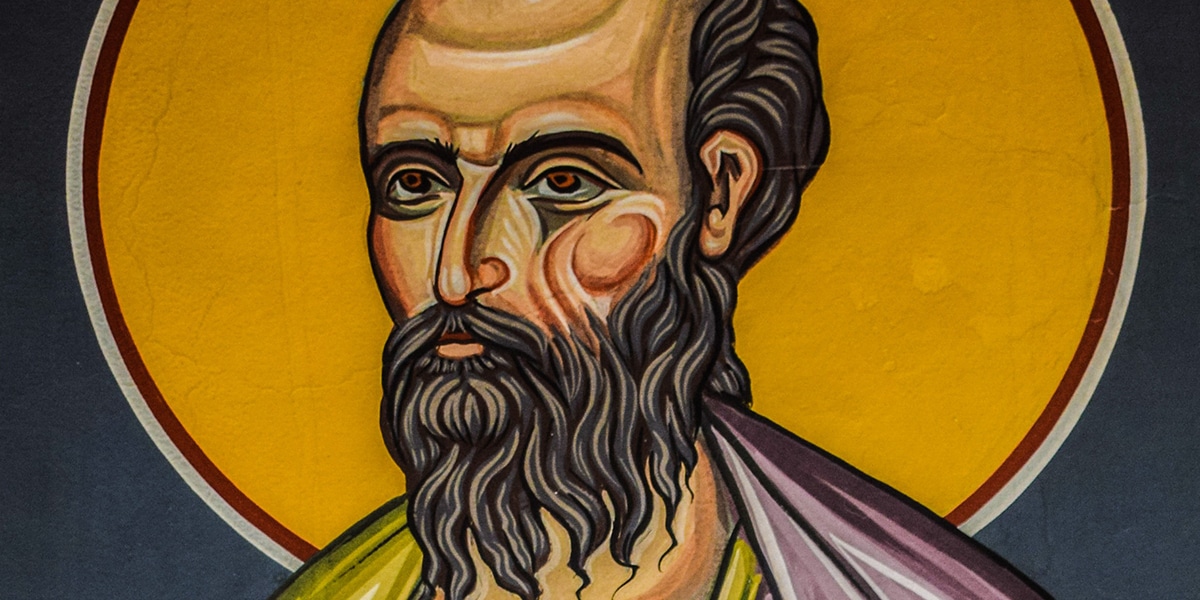St. Paul’s letters to two coworkers and a friend have helped countless Christians over the centuries.
Nine of the letters attributed to Saint Paul were sent to large groups of people: the Romans, Corinthians, Galatians, Ephesians, Philippians, Colossians, and Thessalonians. They are filled with advice, instruction, and spiritual insights for these communities. The remaining four letters, however, were addressed to specific people: Timothy, Titus, and Philemon.
Written later in Paul’s life, they are shorter and a bit more private. Though these letters were perhaps intended to be read by only a few people, they are now quite public because they were copied and shared with other followers of Jesus. For almost 20 centuries, Christians have recognized them as inspired, as words that feed us as much now as they did these first-century Christians. The feast of Saints Timothy and Titus (January 26) uses these letters.
Once a Christian-hater who became a phenomenal Christian leader, Paul, through his letters, guided and strengthened an unfolding Church, helping believers keep their new faith growing, alive, and true. Did Paul realize that these letters would be read for centuries by Christians all over the world? Almost 2,000 years later, they are still full of rich help to countless Christians who strive to nurture their faith. (Unless otherwise noted, all translations are from the New American Bible.)
A Delicate Subject
I am hoping through your prayers to be restored to you (Phlm 22, NRSV).
Although Paul’s very short Letter to Philemon is printed in the New Testament after his letters to Timothy and Titus, most scholars agree that this is the oldest of the four letters described in this article. Because the introduction also addresses Apphia and Archippus, we know that it was not written to Philemon alone. Many biblical commentators presume all three people belonged to the same family. Paul also greets a house church at their home. Because only eight verses from this letter are used in the cycle of Sunday Mass readings, many Catholics may be only vaguely familiar with this letter.
Philemon, Apphia, and Archippus lived in the ancient city of Colossae; its ruins are near the city of Honaz in modern Turkey. They owned a slave named Onesimus. Perhaps discouraged with his status in life, Onesimus ran away, somehow met up with Paul (who was in prison at the time), and was baptized by him. After teaching the runaway slave about the life and message of Christ, Paul apparently sent Onesimus back to his owners (v. 12)—with this personal letter. Paul knew that runaway slaves were often executed if apprehended.
This letter’s 25 verses primarily address the status of Onesimus. Paul obviously feels a strong connection with Philemon’s household and with Onesimus. Readers can sense that Paul feels the vexation of the family that Onesimus left behind, yet readers simultaneously empathize with the slave.
And if he has done you any injustice or owes you anything, charge it to me (v. 18).
Obviously impressed with Onesimus, Paul gently requests that the family welcome back their slave, not execute him. Because the name Onesimus means “useful,” Paul lightheartedly observes that Onesimus, through his accepting Christ, can now better live up to his name.
I urge you on behalf of my child Onesimus, whose father I have become in my imprisonment, who was once useless to you but is now useful to [both] you and me (vv. 10–11). Perhaps this is why he was away from you for a while, that you might have him back forever, no longer as a slave but more than a slave, a brother . . . (15–16a).
While Paul is not forceful about their treatment with the slave he is sending back to them, he gives them much encouragement laced with a nudging toward Christian fellowship (v. 17). Paul’s attitude about slavery eventually prevails among Christians.
Besides dealing with their runaway slave, Paul adds several other personal touches to this letter. For example, he applauds the family by sharing that he had received reports of their great faith in Jesus and of their goodness toward others. He also expresses a hope to visit them soon. This letter was obviously shared with other Christian communities.
The ‘Pastoral Letters’
The two letters to Timothy and the one to Titus are sometimes called “pastoral letters” because of the extensive advice they offer for Church communities in Ephesus and Crete. Although Paul has traditionally been credited as their author, in recent centuries some scholars have challenged that assumption.
The debate is unresolved; the letters may have been written by Paul, by one of his disciples, or by someone else after Paul’s death, using the name of Paul as a pseudonym. Whatever the case, these letters reflect Paul’s theological principles and are accepted as truly inspired.
For this reason I left you [Titus] in Crete so that you might set right what remains to be done (Ti 1:5a).
The Letter to Titus yields no clues to date it precisely. Most chronological listings of Paul’s letters place it very close to or before 1 Timothy. From occasional references to Titus in Paul’s earlier letters, readers can glean a fair amount about this early Church saint. Titus did much to assist Paul with his evangelical works: he went to Jerusalem with Paul and Barnabas (Gal 2:1, presumably to the Council of Jerusalem) and aided Paul on his third missionary journey (10 references in 2 Corinthians and two in Galatians).
Titus was also sent to Corinth to defuse a tense situation between its Christians and Paul; 2 Corinthians 7:13ff indicates that Titus was successful. Titus was evidently trusted as someone who could peacefully guide the veering Corinthians toward a correct faith (2 Cor 7:6–7). Paul writes, “As for Titus, he is my partner and coworker for you” (2 Cor 8:23a).
Titus was working on the Mediterranean island of Crete when he received his letter with Paul’s instructions about how best to build up the Church there. Paul identifies what qualities to look for when choosing presbyters/bishops, what sort of behavior should be urged for all in the community, how to deal with former Christians, how to encourage good works, and more.
A few personal and private messages are blended in as well. Paul calls Titus his “true child in our common faith” (1:4) and expresses confidence in him for developing the Church there. Paul expresses some harsh words, however, for the people of Crete: “liars, vicious beasts, lazy gluttons, vile, and disobedient” (1:12–16), words surely meant for Titus alone to read. Paul implores Titus to remain unswerving with correct doctrine; he directs Titus to act with proper confidence and to dismiss critical attitudes.
Say these things. Exhort and correct with all authority. Let no one look down on you (2:15).
Toward the end of the letter, Paul asks Titus to meet him at Nicopolis, an ancient city in Greece, about 350 miles from Crete (3:12).
Like all of Paul’s personal letters, the Letter to Titus is rather short, only three chapters long. Even though it was meant for Titus and perhaps a few trusted friends of his, it offers great insights into the early Church—and many points to ponder for present-day Christians.
Paul’s Assistant
Timothy’s story begins in chapter 16 of Acts of the Apostles, during Paul’s second missionary journey. Paul is making a return visit to the Christians of Lystra, an unexcavated site in present-day Turkey. Even though his first visit there ended uncomfortably—Paul had been stoned and left for dead (Acts 14:19–20)—a Christian community nonetheless took root there, showing a heart full of faith when Paul returns.
When he reaches Lystra the second time, its Christian community speaks highly of Timothy. Paul is obviously very impressed, for from then on it seems that Timothy is either with Paul or is representing him on special missions. Timothy’s name is peppered throughout the second half of the Acts of the Apostles (16:1; 17:14–15; 18:5; 19:22; 20:4) and Paul’s other letters (Rom 16:21; 1 Cor 4:17, 16:10; 2 Cor 1:1, 1:19; Phil 1:1, 2:19; Col 1:1; 1 Thes 1:1, 3:2, 3:6; 2 Thes 1:1; Phlm 1:1).
O Timothy, guard what has been entrusted to you (1 Tm 6:20a).
At some point, as the Christian faith was gaining momentum, Paul sends Timothy to Ephesus, a city about 275 miles from Timothy’s hometown of Lystra. Timothy’s job in Ephesus is to lead and organize the growing Church there. During his time in Ephesus, he receives Paul’s letter, which is full of encouragement and instruction for Timothy during the time of organization.
The letter has some similarities to Paul’s Letter to Titus and may have even been written at roughly the same time. Some of the topics Paul addresses include warnings against false teachings, advice to pray for people in authority, the qualities to look for when selecting bishops and deacons, the true meaning of wealth, and ways the Church should help widows.
Tell them to do good, to be rich in good works, to be generous, ready to share . . . (1 Tm 6:18).
Also included in this letter are some words directed to Timothy specifically.For example, Paul mentions his desire to visit Timothy soon; but in the event that he is unable, he hopes his letter will offer enough help for Timothy to work with (3:14). Paul reminds him of his blessing with the gift of Christian leadership through the “imposition of hands” (4:14). Paul counsels Timothy to take good care of himself and the Church, which both need attention in order for the Church of Ephesus to succeed.
Stop drinking only water, but have a little wine for the sake of your stomach and your frequent illnesses (1 Tm 5:23).
Evidently Timothy was drinking only water for a time, and Paul presses him to stop this habit, suggesting that he should drink some wine as well. Paul asserts that wine would help Timothy’s stomach and recurrent sicknesses. This comment is probably the reason why Timothy is a patron saint of stomach disorders.
Paul also challenges Timothy to compete for the faith through an attitude of gentleness, truth, and love (6:11).
2 Timothy
Try to join me soon. . . . When you come, bring the cloak I left with Carpus in Troas, the papyrus rolls, and especially the parchments (2 Tm 4:9, 13).
Paul’s Second Letter to Timothy is considered by many to be his last biblical letter. Paul is imprisoned in Rome at the time that the letter was composed; perhaps it was not long before his beheading between AD 64 and 67.
2 Timothy clearly has a different tone; while Paul still gives Timothy, who was probably still in Ephesus, more advice, the letter also includes words expressing some sentiments of distress.
Remember Jesus Christ, raised from the dead, a descendant of David: such is my gospel, for which I am suffering, even to the point of chains, like a criminal. But the word of God is not chained (2 Tm 2:8–9).
One of Paul’s main pastoral points in this letter is that Timothy must avoid foolish arguments and debates; rather, he should remain gentle and tolerant, striving for peace with a pure heart that is devoted to the Lord. Paul also expresses a desire for the good news of Christ to be passed on; that Timothy pass on to others what Paul taught him; they, in turn, can teach even more people (2:2).
Readers can feel Paul’s father-like love and care for Timothy through some more private statements he includes. Early on in the letter, Paul fondly reminisces about the faith of Timothy’s mother and grandmother, Eunice and Lois, whom Paul had met earlier (1:5).
He reminds Timothy that hardships will come his way now and then and that he must endure them with the help of God. Paul pours out his heart to Timothy when he expresses that his death might be approaching. It is to Timothy that Paul sends his famous words: “I have competed well; I have finished the race; I have kept the faith” (2 Tm 4:7).
Paul also shares with Timothy his feelings of loneliness, disheartened that many have deserted him (1:15). He urges Timothy to visit him and expresses hope that Timothy might arrive to see the imprisoned Paul before winter (4:21).
A Two-Week Devotional
All together, these four personal letters of Paul total 14 mostly short chapters. Consider spending two weeks reading these private letters, one chapter per day, maybe checking a footnote or two.
As you read each chapter, try to put yourself in the shoes (or sandals!) of the recipients: Philemon, Apphia, Archippus, Titus, or Timothy. Try to imagine how you might have reacted and see if these words written so many years ago bring new insights to your heart.
Saints Mentioned in These Letters
The main characters from these four letters are all recognized as saints in the Church; their stories give much to admire and inspiration to keep us focused on the Lord:
Timothy (January 26) is considered the patron saint of people with stomach problems.
Titus (January 26) is the patron saint of Crete.
Onesimus (February 15) is sometimes called “blessed” but is usually regarded as a saint. He may be a good patron for those who feel discouraged with their work.
Archippus (March 20) is a possible patron for people who struggle with forgiveness and acceptance, in view of his challenge to treat his family’s former slave, Onesimus, as a Christian brother.
Paul (June 29) is the patron of many causes including writers, journalists, evangelists, and laypeople.
Apphia (November 22) could be the patroness of altar societies; she generously allowed her house to be used for worship in the early Church.
Philemon (November 22) was probably married to Apphia. He would be a good patron for employers, especially those who struggle with personnel issues.
Also mentioned very briefly in these letters are Saints Mark (April 25), Tychicus (April 29), Prisca and Aquila (July 8), Epaphras (July 19), Erastus (July 26), Aristarchus (August 4), Onesiphorus (September 6), Linus (September 23), and Luke (October 18).








